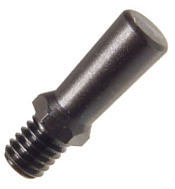
When most people think of handles, they envision traditional bar-style handles with a long and horizontal gripping surface. Handles, however, are available in many other styles Among the simplest styles is finger. They offer a quick and easy way to open access panels, machinery doors and other surfaces. What are finger handles exactly, and how do they differ from traditional handles?
An Introduction to Finger Handles
Finger handles are small, easy-to-use handles designed to be operated with just a few fingers. As shown in the adjacent photo, they are typically shaped like a short rod. You can use them by grabbing the handle surface with a few fingers, such as your index finger and thumb, and then pulling or pushing.
Finger Handle Materials
You can find finger handles in different materials. Common materials in which they are made include plastic, stainless steel, carbon steel and zinc.
Plastic finger handles are lightweight and offer a superior level of resistance to corrosion. Stainless steel finger handles are strong, durable and rust-resistant. Carbon steel finger handles have a higher concentration of carbon, which makes them stronger than stainless steel finger handles. Zinc finger handles are durable, low-maintenance and offer excellent resistant to oxidative stress.
Benefits of Finger Handles
With their small and simple design, finger handles can conserve space. They don’t stick out or protrude from surfaces as much as other styles of handles.
Finger handles are also ergonomic. They aren’t awkward or uncomfortable to grip. On the contrary, finger handles are quite comfortable. You can grab them with just a few fingers, followed by pulling open or pushing closed the surface on which they are used.
Finger handles are stylish. They feature a sleek, modern appearance that integrates well into many workspaces. So, if you’re tired of using a large, uncomfortable and unattractive handle in your workspace, you may want to switch to a finger handle.
How Finger Handles Are Installed
There are different types of finger handles, but most of them are installed via a threaded base. The base of a finger handle is threaded. To install it, you just need to twist it into a threaded hole of the same size.
Threaded finger handles such as this don’t require any special tools or fasteners to install. As long as the surface has a threaded hole of the same size, it will support the finger handle. Just twist the finger handle’s threaded base into the hole.
